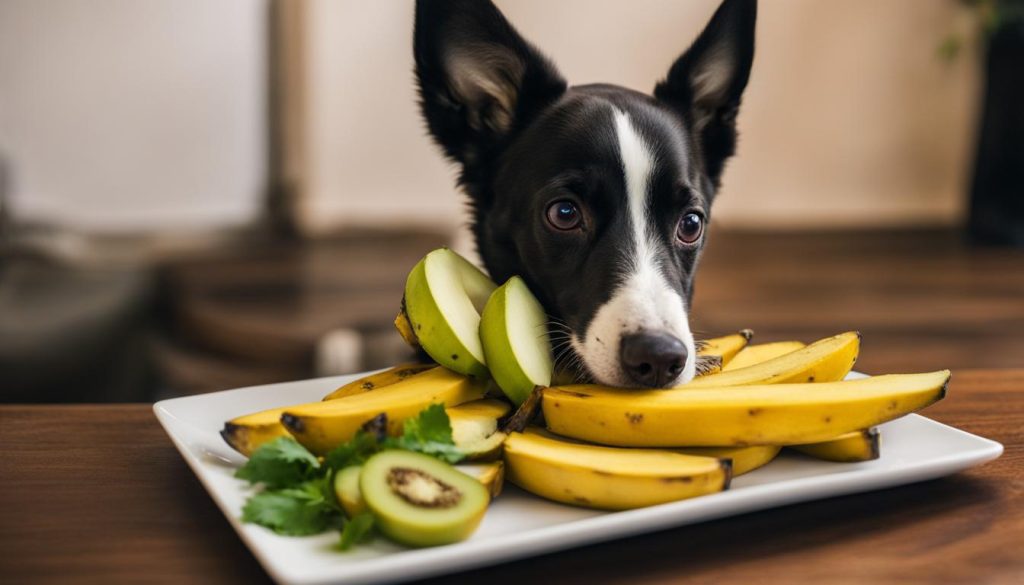As a passionate pet owner, I’ve often wondered about the variety of human foods that my furry friend can safely enjoy. “Can dogs eat plantains?” is a question I’ve heard from fellow dog lovers who are eager to add diversity to their pet’s diet. Well, it’s time to peel back the layers of this query! Plantains, the tropical fruit that thrives in the culinary traditions of many cultures, aren’t just for humans. When I learned about the possibility of incorporating plantains into my dog’s meal plan, I was intrigued by the potential benefits and mindful of the safety precautions necessary to make it a paw-sitive experience.
When asking “are plantains safe for dogs”, the answer is encouragingly positive, with a few caveats. Unlike their sweeter counterparts – the bananas mostly devoured in the U.S. and Europe – plantains are starch-heavy and usually included in savory dishes, especially in the regions where they grow abundantly. It’s essential to recognize that edible plantains are vastly different from plantain lilies, which are toxic to canines. So, as we explore how to introduce dog-friendly plantain recipes into our pet’s diet, let’s ensure we’re doing so with their health and happiness in mind.
With a careful approach, you can integrate plantains into your dog’s diet as a nutritious treat. Are you ready to learn more about safe feeding tips for dogs and how you can include this delightful fruit in your furry friend’s snack time? Let’s delve into the dos and don’ts and whip up some tail-wagging treats!
Can Dogs Eat Plantains? Yes, it is okay in limited quantities.
- Plantains are starch-rich tropical fruit that can be included in a dog’s diet when cooked properly.
- Be sure to differentiate between pet-safe plantains and toxic plantain lilies.
- Feed cooked plantains to your dog to avoid digestive issues associated with raw ones.
- Start slow and serve plantains in moderation to ensure your dog tolerates this new treat.
- Explore dog-friendly plantain recipes that exclude harmful seasonings and excess fats.
- Always consult a veterinarian before adding new foods to your dog’s diet, particularly if they have health conditions.
Understanding Plantains in Your Dog’s Diet
As I delve into the specifics of incorporating plantains into the diets of our canine friends, it’s vital to highlight the distinctive attributes that make plantains more than just a banana relative. They are a rich source of nutrients that can play a beneficial role in maintaining the health and well-being of dogs. So, let’s break down what exactly makes plantains a worthwhile addition to your dog’s diet.
Nutritional Profile of Plantains
Exploring the nutritional value of plantains for dogs reveals a promising array of vitamins and minerals. Packed with energy-rich carbohydrates, these tropical staples can offer a quick source of energy while ensuring that our pets get their essential nutrients. It’s the balance of vitamins A, C, B6, potassium, and magnesium that particularly stands out, contributing to various facets of canine health such as immune system support and cardiovascular wellness.

Comparing Plantains to Common Fruits and Vegetables
When weighing the benefits of dogs and plantains against other fruits and veggies, it’s the fiber content in plantains that places them a paw ahead. The fiber can aid in digestion and regulate glucose levels, providing a slow and steady source of energy that’s favorable for dogs, especially those with weight management needs. However, moderation is key to preventing any digestive discomfort or an imbalance in your dog’s diet.
The Role of Carbohydrates and Fiber in Canine Health
Even though proteins take the lead in a dog’s diet, the role of carbohydrates and fiber should not be overlooked, and that’s where plantains excel. Plantains and canine health go hand-in-paw, especially when considering the benefits of fiber for maintaining regular bowel movements and contributing to a sense of satiety. Feeding plantains may bring not only nutritional benefits but also improve the quality of your dog’s daily dietary routine.
Overall, carefully integrating plantains into your dog’s meals can be a delightful way to enhance their diet while ensuring they stay healthy and vibrant.
Can Dogs Eat Plantains: Safety and Portioning
When it comes to treating our canine companions, many of us are keen on sharing the benefits of our own healthy snacks, such as plantains. However, the risks of feeding plantains to dogs should not be ignored. As I explore the suitability of plantains for my dog, I’ve learned that while dogs can eat plantains, there are important safety measures and portion sizes to consider.
Firstly, we should avoid raw plantains because they contain difficult-to-digest fibers that may lead to gastrointestinal distress in dogs. Cooking the plantains until they are soft is the best method, as it breaks down those tough fibers, making them easier for dogs to digest. Dog-friendly plantain recipes often involve boiling or grilling to attain the right texture without adding unhealthy fats.
Fried plantains, on the other hand, are a definite no-go. They contain excess calories and harmful fats that can contribute to serious health issues like pancreatitis and obesity in dogs. And let’s not forget about plantain chips — these are typically processed and can contain added salt and seasonings such as garlic and onion, potentially posing the threat of sodium poisoning or bloat.
The key to incorporating plantains into your dog’s diet safely is moderation. I make sure to only serve small portions of plantains occasionally, which helps to prevent any adverse health effects. Gradually introducing plantains to my dog also ensures that his system has time to adapt to the new food.

As a dog owner, understanding the balance and ensuring the safety of my dog’s diet is of the utmost importance. With careful consideration of these guidelines, plantains can be a healthy and enjoyable treat for our furry friends.
Uncovering the Benefits of Plantains for Dogs
As a conscientious dog owner, I’m always on the lookout for ways to enrich my furry friend’s diet with nutritious foods. That’s when I discovered the benefits of plantains for dogs. Not only are they packed with valuable nutrients, but they also contribute to canine health in more ways than one. Let’s delve into the specifics and see how these tropical fruits can be a smart addition to your dog’s meal regimen.
Health Advantages of Dietary Fiber in Plantains
The dietary fiber in plantains is an unsung hero when it comes to managing my dog’s weight and supporting his digestive health. Often, I’ve noticed how a well-fibered meal can help him feel full without the need for excessive calories. This natural laxative effect also ensures his bowel movements are regular, reducing any odds of constipation. More so, fiber has been great for his dental health; it helps to mechanically clean the teeth, thus decreasing plaque buildup and the risk of gingivitis.
The Vital Vitamins and Minerals in Plantains
What’s truly impressive about plantains is their dense content of vitamins and minerals, critical for maintaining my dog’s well-being. The magnesium in plantains, for instance, has anti-inflammatory properties, providing much-needed relief from conditions like arthritis. Plus, the potassium in these starchy fruits is essential for heart health. And let’s not overlook vitamin C, an antioxidant that boosts immunity, reducing the risk of certain diseases and playing a pivotal role in collagen production for healthy skin and coat.
Integrating Plantains for a Balanced Canine Diet
Integrating plantains into my dog’s diet has been a rewarding experience, though it’s something I approach with balance and caution. The nutritional value of plantains for dogs cannot be understated, but they should never replace the primary components of his meals, which are rich in animal proteins. By adding appropriately portioned plantains, I’m able to enhance his diet and let him enjoy the variety of flavors and textures, all while reaping the health advantages.
How to Serve Plantains to Your Pup
As a devoted pet parent, I’m always on the lookout for dog-friendly plantain recipes that I can share with you. Plantains can be a tasty and nutritious addition to your dog’s diet, provided they’re prepared correctly. I’ve discovered that the best way to feed your dog plantain is by steaming them. This method is most effective in preserving the fruit’s nutrients while making it gentle on your pup’s digestive system.
Once the plantains are steamed to perfection, I like to go one step further by mashing or cutting them into small, bite-sized pieces. These are easy for your dog to eat and digest. In my experience, the simpler the preparation, the better it is for your furry friend’s health. So, it’s crucial to avoid any additives—skip the salt, butter, and especially sugar. We’re aiming for natural flavors that won’t upset your dog’s stomach.
Starting with a small serving size is the best approach. It gives me a chance to see how my dog reacts to this new ingredient in their diet. If you’re contemplating adding plantains in your dog’s diet, remember that moderation is essential. Use plantains as a special treat or mix them with your dog’s usual meal to add a bit of variety.
I’ve seen firsthand how introducing new foods like plantains can spark joy in mealtime for dogs. But as always, keep a watchful eye for any changes that suggest they aren’t responding well to the new food. Trust me, the tail wags you’ll get from a happy, healthy pup are worth this simple culinary effort!
Conclusion
As pet owners, we often find ourselves questioning which foods are safe for our canine friends, particularly when it comes to less common items like plantains. I’ve examined the nuances of introducing plantains into your dog’s diet, and it’s clear that when they are prepared properly and served in moderation, dogs and plantains can indeed get along quite well. The key is cooking the plantains to ensure they’re easily digestible, and keeping an eye on how much your dog consumes to prevent any potential issues.
Understanding the benefits of plantains for dogs is essential, as they can offer a wealth of nutrients that contribute to your dog’s health. Packed with vitamins, minerals, and fiber, these starchy fruits can aid in digestion, immune function, and overall well-being. But I also emphasize the necessity of consulting with a vet when introducing any new food to your companion’s regimen, particularly for those pups with existing health conditions. It’s all about fostering optimal canine health while providing a varied and interesting diet.
In essence, the question of can dogs eat plantains doesn’t require a complicated answer. Yes, they can, but like any responsible pet parent knows, it’s all about balance and consideration. So, by implementing the straightforward tips on preparation and portioning covered in this guide, you can feel at ease offering plantains as a nutritious addition to your dog’s occasional treats. Here’s to happy, healthy, and well-fed pooches!
FAQ
Can dogs eat plantains?
Yes, dogs can eat plantains as long as they are cooked and not served raw. Cooked plantains are a safe and nutritious treat for dogs when given in moderation.
Are plantains safe for dogs?
Plantains are safe for dogs if they are properly prepared. This means they should be cooked without added fats, sugars, or seasonings and offered in small, manageable portions as part of a balanced diet.
What are the nutritional benefits of plantains for dogs?
Plantains provide a range of nutrients beneficial to dogs, such as dietary fiber for digestive health, vitamins A, C, and B6 for immune support and energy metabolism, and minerals like potassium and magnesium for heart health and muscle function.
How do plantains compare to common fruits and vegetables in a dog’s diet?
Plantains are higher in carbohydrates and dietary fiber compared to many common fruits and vegetables. They are a good source of energy and can help maintain digestive health when given as part of a varied diet.
What’s the role of carbohydrates and fiber from plantains in canine health?
Carbohydrates provide energy, while fiber aids in digestion. They help control weight, support bowel health, and may benefit cholesterol levels. However, excessive amounts can be harmful, especially for diabetic dogs, so moderation is essential.
What are the risks of feeding plantains to dogs?
The primary risks include digestive upset from raw plantains, obesity and pancreatitis from feeding fried plantains or plantains with added fats, and potential sodium poisoning from processed plantain chips. Overfeeding can also upset the balance of a dog’s diet.
How can I incorporate plantains into my dog’s diet?
Start by cooking the plantains until soft, then mash or chop them into small, bite-size pieces. Introduce them gradually into your dog’s diet as a treat, ensuring they’re free from harmful additives or excessive salts.
Are there any dog-friendly plantain recipes?
Yes, steaming plantains and mashing them without added ingredients can be a simple and healthy way to create a dog-friendly treat. It’s important not to include any harmful seasonings or excessive salts in any plantain recipe for dogs.
What are the health advantages of dietary fiber in plantains for dogs?
Dietary fiber in plantains can help regulate digestion, provide a feeling of fullness, which is useful for weight management, and promote overall colon health. It can also assist in blood sugar regulation and offer dental health benefits.
What vitamins and minerals in plantains are important for dogs?
Plantains contain essential vitamins and minerals such as vitamin A for eye health, vitamin C for immune support and antioxidant function, vitamin B6 for protein metabolism, potassium for nerve and muscle function, and magnesium for bone health and enzymatic reactions.
How should I serve plantains to my dog?
Serve plantains cooked and in moderation. They should be plain, with no added fats or seasonings, and can be mixed with your pup’s regular meal or given as a separate treat. Always cut them into appropriate sizes to prevent choking.
What should I consider before feeding my dog plantains?
Before introducing plantains, or any new food, into your dog’s diet, consult your veterinarian. Be mindful of serving size and frequency, as well as your dog’s overall health status, to ensure the treat contributes positively to their diet without causing issues.






